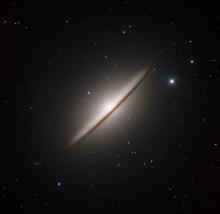Listen to today's episode of StarDate on the web the same day it airs in high-quality streaming audio without any extra ads or announcements. Choose a $8 one-month pass, or listen every day for a year for just $30.
You are here
Hot DOGs
Astronomers recently found a sizzling “hot dog” in space. It’s not a Nathan’s dog from Coney Island, or a Pink’s hot dog from L.A. Instead, it’s a hot dust-obscured galaxy — one of the most powerful objects in the universe.
Such galaxies are powered by supermassive black holes in their cores. Gas and dust fall toward the black hole, forming a swirling disk around it. It can shine brighter than all the stars in the galaxy combined. That makes the galaxy a quasar — one of the brightest objects in the universe.
“Hot dogs” are even brighter than normal quasars. They contain huge amounts of dust. The dust absorbs a galaxy’s visible light, so it’s not very bright to the eye alone.
But the dust is heated by radiation from the disk around the black hole, so it, too, shines brightly — in the infrared. A hot dog can shine up to a hundred trillion times brighter than the Sun — a thousand times brighter than our entire galaxy.
The newly discovered hot dog is the closest yet seen — just a few billion light-years away. Its black hole is about 250 million times the mass of the Sun. The galaxy is giving birth to lots of new stars. But radiation from the hot disk is blowing away the gas that gives birth to stars. So the rate of starbirth is likely to plunge.
The new hot dog is to the lower right of Cygnus, the swan, which is high in the west at nightfall. Despite its brilliance, the galaxy is far too faint to see without a telescope.
Script by Damond Benningfield






